STUDIO TAN: CLASSICISM
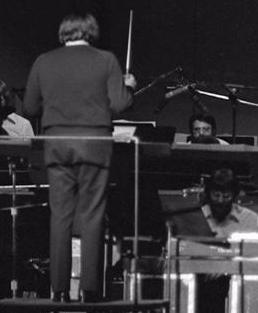 In 1975 Zappa hired a group of session musicians to form the 37-piece Abnuceals Emuukha Electric Orchestra
with Michael Zearott conducting (photo to the left taken from the "Quaudiophiliac" DVD by the ZFT).
He did two live concert evenings with them including himself on guitar and the rhythm section
of his rockband. The recordings landed mostly on "Orchestral favorites", but some sections also on "Studio tan". Their
release got delayed because of his clash with Warner Bros. (see the Zappa in New York
section). "Studio tan" appeared in 1978 and, when he was back in business again in 1979 with "Sheik Yerbouti",
Warner Bros. released these last "Orchestral favorites" tapes they had in their closet with a non-informative low budget album cover, four years after
their recording. Zappa himself called the album "ill fated". With this CD he partly returned to earlier compositions from
"200 Motels" as he would do again later on with the "L.S.O. Vol. II" album of 1987. "Orchestral favorites"
never has received much attention, partly because the compositions all returned on later albums
with a higher sound quality (except for "Duke of prunes"). But by itself there is nothing wrong
with this album, quite the contrary. The 2019 "Orchestral favorites 40th anniversary" release by the ZFT helps
in improving the atmosphere surrounding the project by including one of the two live concerts held during the recording sessions.
In 1975 Zappa hired a group of session musicians to form the 37-piece Abnuceals Emuukha Electric Orchestra
with Michael Zearott conducting (photo to the left taken from the "Quaudiophiliac" DVD by the ZFT).
He did two live concert evenings with them including himself on guitar and the rhythm section
of his rockband. The recordings landed mostly on "Orchestral favorites", but some sections also on "Studio tan". Their
release got delayed because of his clash with Warner Bros. (see the Zappa in New York
section). "Studio tan" appeared in 1978 and, when he was back in business again in 1979 with "Sheik Yerbouti",
Warner Bros. released these last "Orchestral favorites" tapes they had in their closet with a non-informative low budget album cover, four years after
their recording. Zappa himself called the album "ill fated". With this CD he partly returned to earlier compositions from
"200 Motels" as he would do again later on with the "L.S.O. Vol. II" album of 1987. "Orchestral favorites"
never has received much attention, partly because the compositions all returned on later albums
with a higher sound quality (except for "Duke of prunes"). But by itself there is nothing wrong
with this album, quite the contrary. The 2019 "Orchestral favorites 40th anniversary" release by the ZFT helps
in improving the atmosphere surrounding the project by including one of the two live concerts held during the recording sessions.
1. Strictly genteel (1975)
In the "200 Motels" closing piece "Strictly genteel" the variations form is used with "Lord have mercy..."
as the central theme. It's the most classical piece in Zappa's output. Not only because of its variation form, also because of its
use of standard chords and a steady meter.
"Strictly genteel" re-appeared on the "Orchestral favorites" and "L.S.O. vol. II" albums.
See the London Symphony Orchestra section for the details and a number of variations upon this theme (harmonically as well as using counterpoint).
Another directly recognizable classical form is the following.
On "200 Motels", disc 1, tracks 14-18, the rondo set up is used with
"She painted up her face"
as the central theme (see the 200 Motels section for this theme). Musically as well as lyrically this is a clearly rounded off story about a groupie
preparing herself for going out (numbers are the track numbers):
- 14. 0:00. Theme A: She painted up her face.
- 14. 1:06. Theme B: The secret stair she could use.
- 15. 0:00. Theme C: Janet's big dance number.
- 16. 0:00. Theme A: The clock upon the wall.
- 16. 0:45. Theme D: Half a dozen provocative squats.
- 17. 0:00. Theme E: Mysterioso.
- 18. 0:00. Theme A: She chooses all her clothes.
- 18. 1:00. Theme F: Shove it right in.
Strictly genteel: Every poor soul who's adrift in the storm (midi file).
Strictly genteel: Every poor soul who's adrift in the storm (score/transcription).
The above example from "Strictly genteel" is played between 1:26 and 1:42 on "Orchestral favorites". Bars 1-3 are transcribed by me. I'm not positive
about the voicing and exact notes of the chords. As I'm hearing it, it's a progression of triads over a sustained D7 chord with some additional melodic notes.
Bars 4-7 are the original score in a reduced form. It can be found in a thumbnail format in the "200 Motels" booklet, with this section being titled
"Every poor soul who's adrift in the storm":
- bars 4-5: G pedal with a G Lydian sonority.
- bars 6-7: A pedal with A major. A fast melodic line is played with a number of parallels: octaves and other intervals. Zappa wrote his "200 Motels" score
from an ideal situation where the size of an orchestra and rehearsal time formed no hindrance. In all executions of these scores you can hear concessions
had to made. In this case the three prescribed pianos weren't available and several staves got skipped. On the other hand the electric bass line from the bottom staff
in the example got added to the score. In case of Zappa the sheet music should be taken into account as individual versions too. The sheet music
is seldom 100 % identical to what you can hear on recordings of it.
Strictly genteel (1975), 0:00-0:14 (midi file).
Strictly genteel (1975), 0:00-0:14 (transcription).
Strictly genteel is present in Zappa's own output on four different albums, next to the written music.
These versions differ regarding add-ins and instrumentation, as well as various details. So there are five versions available via:
- "200 Motels".
- "Orchestral favorites".
- "The L.S.O."
- "Make a jazz noise here".
- The sheet music.
The add-ins get described in the 200 Motels and L.S.O.
sections of this study. As it comes to the details you can compare the 1975 version of the opening with the examples in the other sections of this study. In 1971
Zappa wrote out everything in detail. My guess is that the piano player could improvise along the chords rather than that Zappa wrote out the example of the 1975 opening
in detail too. The improvised part mostly concerns the melodic additions from staff 1. It must have been indicated to use triplets over most beats: the drummer is doing this too
(not included in the example above).
2. Pedro's dowry (1975)
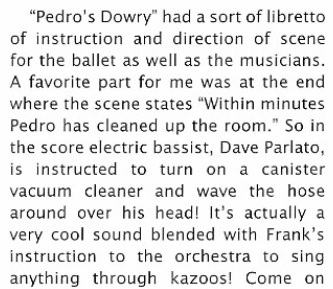 Of a completely different nature is "Pedro's dowry". It's atonal, difficult and versatile to the point of getting brutal.
"Pedro's dowry (1983)" also returned on the "L.S.O. vol. I" album. Other than
tracks 1, 3 and 5, it remained basically the same, that is without re-working upon its construction and only a few additions. Excerpts from this composition
are presented in the L.S.O. section of this study as well.
Of a completely different nature is "Pedro's dowry". It's atonal, difficult and versatile to the point of getting brutal.
"Pedro's dowry (1983)" also returned on the "L.S.O. vol. I" album. Other than
tracks 1, 3 and 5, it remained basically the same, that is without re-working upon its construction and only a few additions. Excerpts from this composition
are presented in the L.S.O. section of this study as well.
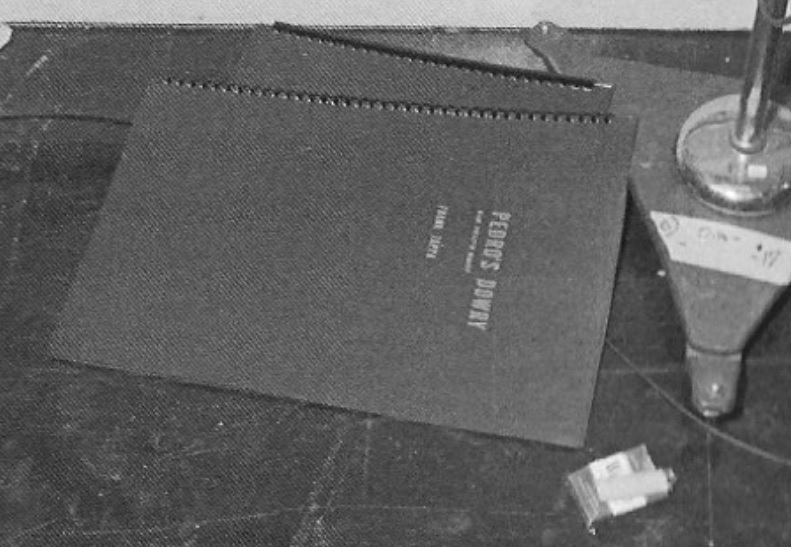
Above to the right Terry Bozzio's comment upon the choreography of "Pedro's dowry". Source: the Orchestral favorites 40th anniversary CD.
Disc 2 of this CD includes "The story of Pedro's dowry" as track 4, beginning with: "The name of this tune is "Pedro's dowry". Let me tell
you the story here. This was also written as a ballet, but we just don't have the budget for that sort of thing. Here is the plot. A woman,
with ocean front property, waits for someone named Pedro in a skiff, a form of a boat".
Right above you can see the score of "Pedro's dowry" lying on the floor during the rehearsels. See the inner sleeve of "Sheik Yerbouti" for a closer look
at the cigarettes and the L.S.O. section of this study for samples from the score. During "The story of Pedro's dowry" you can hear how Zappa himself
pronounced the title, "Pedro" sounding as "pay-dro".
Pedro's dowry (1975), 5:21-5:39 (midi file).
Pedro's dowry (1975), 5:21-5:39 (score/transcription).
On Youtube Chanan Hanspal is showing a few examples from the reduced original score of "Pedro's dowry". By the lettertype you can tell it's from around 1975.
I took bars 130-131 as the starting point for the example from above. In the first bar a clarinet and flute are repeating a figure each beat.
Suddenly the tempo drops drastically in bar 2. Two flutes are now playing this figure during a bar. In bar 3 bassoons are playing a figure against it using triplets.
In bars 4-5 a melody is played, first some single notes in bar 3, next a fast string of notes, where the duration of the notes is changing per beat.
Of course all is atonal and irregular. Because of the tempo hardly anyone may have noticed the clarinet player hits a B instead of an A in beat 3.
For the 1983 recording with the L.S.O. hardly any changes were made upon these bars, only the two percussion quintuplets were
left out and the doubling on marimba is absent or hardly audible. It can be heard between 6:31 and 6:52 on the 1983 CD.
3. Naval aviation in art?
"Naval aviation in art?" knows three versions, one on "Studio tan", one on "The perfect stranger" from 1984, and one included in the ZFT release "200 Motels, 50th anniversary edition" from 2021. The corresponding score of the latter version is carrying the title "Jeff and Don" for the movie, but only a small section can actually be heard during the film version of "200 Motels". It's not included in the soundtrack CD, nor in the Suites edition of "200 Motels". It did get recorded in full in 1971, as the "200 Motels, 50th anniversary edition" is proving. The two earlier released recorded versions are pretty different regarding their details. All three versions are being dealt with in the The perfect stranger section of this study.
4. Duke of prunes (1963-1975)
On "200 Motels"/"Orchestral favorites"/"L.S.O. Vol. II" there are some examples of the use
of forms that you might call "classic". We'll take a look at a sonata movement, a rondo and the variations form.
The term sonata form can either refer to a piece for one or two instruments
made up of several movements
or to the construction of a single movement. Zappa didn't do the first,
but "Duke of prunes" ultimately developed into something of a sonata movement in the second meaning of the word in
three stages. Theme A of the 1975 movement is the "Original duke of prunes" from the "Run home
slow" soundtrack for a small chamber ensemble.
In this soundtrack from 1963 theme A is played over the Fmaj9 and Em9 chords alternating, similar to
the "The duke of prunes, 1967" version from "Absolutely free". In that section the keys are identified as E Phrygian and E minor. Up till the 4th edition
of this study I called these two chords I 7th and II 7th
of A Dorian, but I misheard an F being natural during the first chord (and there's an E pedal note, better to be taken as
tonic). It doesn't really sound wrong as I had it originally, but one note being different can be sufficient to get your analysis wrong.
Original duke of prunes, 1963 (midi file).
Original duke of prunes, 1963 (transcription).
The main theme from the "Duke of prunes" is also coming by in the study by Brett Clement. I've added his analysis to the example from above.
In the left menu you can find a discussion between me and Brett taking place about keys. Since I made some mistakes here, some further comment is in place.
As I'm hearing it now all versions of theme A are alternating the Fmaj9 and Em9 chords.
- Brett calls Fmaj9 over the F pedal F Lydian. Correcty so, I agree.
Brett calls the bars over an E pedal E Dorian.
- Fmaj9 over an E pedal: no, that's better called E Phrygian.
- Em9 over an E pedal: not really accurate neither. Nowhere does the C turn up as sharp. In these specific bars it concerns the lead melody.
Brett tries to explain this away by stating that the sung lead melody follows C Lydian, as if some kind of bitonality is taking place.
That's pretty far-fetched, even for the lead melody by itself. When you call these bars E minor, all parts go by the book.
After 1963 "Duke of prunes" returned twice. On "Absolutely
free" in a rock band version with additional themes and lyrics
like the section below, that represents half of theme B. The key tends towards E Dorian, but not really in a stable manner.
Altered notes turn up as well and the vocalists are sometimes singing rather flat. Then in 1975 it's turned into
an instrumental sonata movement with some freedom. Here it's played by wind instruments, brass
and a rock combo of four persons (guitar, bass, percussion
and drums). The third section below is from this 1975 execution, beginning with one of the guitar
intermezzi from the block in the middle, followed by the orchestra playing.
The duke of prunes regains his chops, 1967, 0:32-0:48 (midi file).
Duke of prunes, 1975, 2:55 till 3:20 (midi file).
The duke of prunes regains his chops, 1967, 0:32-0:48 (transcription).
Duke of prunes, 1975, 2:55 till 3:20 (transcription).
The construction of the 1975 version goes as:
- 0:00 Theme A.
- 0:41 Theme B.
- 1:16 Theme C.
- 1:28 Middle section, guitar solo.
- 2:07 ,, , orchestra and guitar intermezzi.
- 3:24 Theme A returns.
- 4:03 Coda.
- 4:19 End.
At the beginning theme A is played over A-E-F-E as subsequent bass
pedal notes at first, next F and E alternating. Former issues of this study wrongly said G-A, rather careless, but with 450 examples
errors like this happen. Thus it goes similar to the second example from the 1967 version.
Also here the chords are Fmaj9 and Em9.
These two alternating bass notes return as the accompaniment
basis for the guitar
solo. Other examples that relate the middle block to the opening themes are
for instance:
- The motif E-G sharp-F sharp of theme B ("And I know,...") returns at 2:45.
- The opening motif of theme C (F-G-A flat, "And so my darling...") returns slowly at 3:05, followed by a down going
fourth, that's so characteristic of theme A.
- The triplet time at 0:59 returns at 3:17.
The transcribed section begins with a little solo section of 8 bars over a bass lick playing around a G#-B-D movement. The key
is G# minor or Phrygian (there's no A or A# to determine which one it is). Next the brass re-enters and the guitar starts
feedbacking for some bars. The band modulates to a different scale. The bass pedal note in bars 14-17 has moved to F, so you could say
this part is in F minor. Or with the first chord being Bb you could say it starts
in Bb Dorian, but the changing bass notes don't let any note really function as key note. In bar 18 the piece modulates
again, now to E. The incomplete ending bar of the transcription marks another transition to C Lydian.
5. Bogus pomp (1975)
The "Tuna sandwich" suite from "200 Motels" reappeared on "Orchestral favorites" and the "L.S.O. vol. II" albums
(this suite being disc I, tracks 4-8 from "200 Motels"). All in a new jacket with additions and a different sequence.
It got renamed as "Bogus pomp". The L.S.O. version also includes the "Overture" and "Centerville". I'm taking some sections from this composition to give some
examples how Zappa could use variations. The main theme below, "This town is a sealed tuna sandwich
(prologue)", is introduced slowly with lyrics on track 4 of disc I of "200 Motels".
This town is a sealed tuna sandwich, prologue (midi file).
This town is a sealed tuna sandwich, prologue (transcription/score).
There are some differences between the sheet music and the album version. Zappa notated the "Prologue" in 2/4 with the eighth
note as basic time unit. It has a tempo indication in its header: "Slow, rubato".
The piece
is indeed performed in a rubato way, the tempo isn't constant all through. I've added the metronome tempos
at various points in the transcription from above according to how it's performed on record. Again, as in "Nun suit" from the earlier "200 Motels"
section, during the actual recordings for "200 Motels" some modifications upon the score were made.
The sustaining of the notes "We get a ..." and "I think we ..." was
skipped, they are sung as normal eight notes. On the other hand the ritenuto effect wasn't prescribed.
The sustained fourth and eighth notes for "Glued", "Tour" and "(Be-)fore" are notated via
normal half notes in my transcription, but
that duration could very well be a coincidence, in the sense that sustaining them augmented them to more or less
the duration of half notes. Due to the rubato it becomes difficult to say what the best notation is.
Notable is that on record a Db and a Bb in the bass were added as pick up notes for restarting singing
after the sustained notes. The actual accompaniment is less elaborate than as notated.
Maybe I'll look into this again and include a literal midi file of the original score version as well in a future update.
This main theme gets varied upon on several
occasions. Beneath are three of its re-appearances in "Bogus pomp": first its reintroduction, then an atonal
piano variation and thirdly how it's used during the coda.
Bogus pomp, tuna sandwich theme (midi file).
Bogus pomp, tuna sandwich piano variation (midi file).
Bogus pomp, tuna sandwich coda variation (midi file).
Bogus pomp, sections (transcription).
"This town is a sealed tuna sandwich
(prologue)" is atonal. The first and third variation above are diatonic however, in E and D respectively. In the third
example the D by the bass guitar dominates the lower register for “Orchestral favorites”, but there’s also a G chord
in the background. It’s hard to hear how this chord is positioned straight from record. On the L.S.O. version the D dominates
less and it looks like the B of this chord is the pedal note, or possibly the G. The piano variation is also present in this
study in the shape of a re-orchestration for strings as the "Bogus pomp" (1983)
example in the L.S.O. section. "Dance of the just plain folks"
and "Tuna fish promenade & The sealed tuna bolero"
are other sections from "Bogus pomp", that I'm dealing with in the Fillmore East 1970 and 200 Motels sections.

The opening page of the "The tuna sandwich ballet" section from "Bogus Pomp" in Zappa's 1971 handwriting.
It premiered on "200 Motels" as "Dance of the just plain folks". See the Funky nothingness section of this study for the first two pages in a smaller format
and a midi file based upon it.
Black napkins instructions
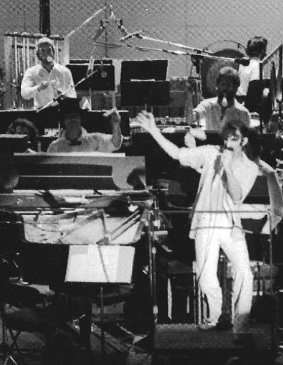 The recordings with the Abnuceals Emuukha Electric Orchestra were done at the Royce Hall, part of the UCLA university campus in L.A.
During the evenings two concerts were held as well. The audience reacted well to the complicated often new music they got to hear.
Zappa spend much time in explaining them what was going on (to the right an outtake of one of the photos by John Williams as reproduced
in the 40th anniversary booklet). The orchestra had to play a lot of this complicated music with relatively
little rehearsal time, so the live recordings weren't sharp enough for official albums. The ZFT included the second concert in its entirety
on their "Orchestral favorites 40th anniversary" CD. Though no new musical angles are offered, it gives a better idea of the project.
Of interest are a few improvisation sections, as well as Zappa's comments. "Black napkins" gets preceded by five minutes of
"Black napkins instructions", where its vamp (in the shape of a chord alternation) gets explained and orchestrated as shown below.
The recordings with the Abnuceals Emuukha Electric Orchestra were done at the Royce Hall, part of the UCLA university campus in L.A.
During the evenings two concerts were held as well. The audience reacted well to the complicated often new music they got to hear.
Zappa spend much time in explaining them what was going on (to the right an outtake of one of the photos by John Williams as reproduced
in the 40th anniversary booklet). The orchestra had to play a lot of this complicated music with relatively
little rehearsal time, so the live recordings weren't sharp enough for official albums. The ZFT included the second concert in its entirety
on their "Orchestral favorites 40th anniversary" CD. Though no new musical angles are offered, it gives a better idea of the project.
Of interest are a few improvisation sections, as well as Zappa's comments. "Black napkins" gets preceded by five minutes of
"Black napkins instructions", where its vamp (in the shape of a chord alternation) gets explained and orchestrated as shown below.
Chords
1:08 "The changes for this song are C#m, for two bars, DM7, for two bars, and that's it ..."
Meter
1:16 "... and it's in 3/4 ..."
Instrumentation, basis
1:18 "... and we'll voice it out, uh, let's see.
Well you guys can pick any voicing, it's like a ..., let's put a suspension on top with a C uh, you can have a C#,
a B and an F#, that'll stay over both chords. Only low register instruments can play the note D when it changes to the, uh, DM7,
and the low brass should be voiced out with a bass trombone and a tuba with a, a D on the bottom and then both you guys play
E a 9th over that, French horns the A in the middle, ok? And then the trumpets, uh, uh, see ... C#, F# and B, and, when
it goes to the, uh, the C#m chord you guys are still on that same notes and you guys move uh a-hen-na-hen-na, now the D goes down
to a C#, the A goes to a G# and the E stays where it is, ok? All right?"
Tempo
2:28 "So can we hear that just a little bit, you know, it's just about one-two-three, one-two-three?"
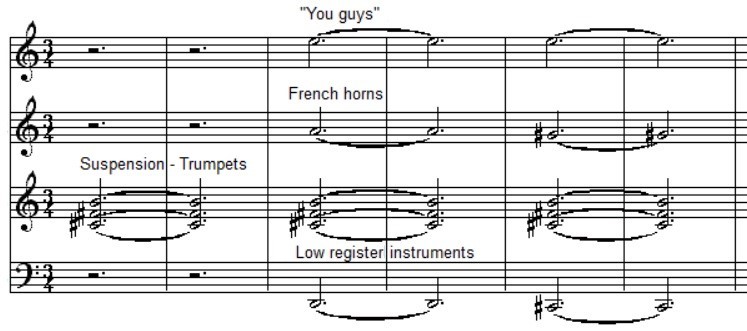
These chords along the instruction (concert score).
Because of the suspension with C#-B-F# the chords are getting larger:
- DM7 => D-F#-A-C#-E-B = D13 (no 11th).
- C#m => C#-E-G#-B-F# = C#m11 (no 9th).
Theoretically speaking, all by itself, the vamp could be interpreted as a I-II
chord alternation in C# Phrygian, or I-VII in D Lydian in the following order from above if you like. During all performances, however,
they are used for implying a modulation scheme with over C#m7:
- C#-D#-E-F#-G#-A-B = C# minor/Aeolian.
- C#-D#-E-F#-G#-A#-B = C# Dorian.
And over DM7:
- D-E-F#-G#-A-B-C# = D Lydian.
Zappa continues with:
Instrumentation, doubling parts for the other instruments
2:56 "Similar voicing over here, I'd like to have a ... both you guys on baritone playing those ..., that boring root
progression and uh, you stay on the alto, you stay on the sarrusophone, play the boring bottom end of it, everybody else
grab any of the notes in between, uh, three piccolos ..."
When you're listening to this track repeatedly, you'll notice that this instruction is used for entertaining and informing
the audience about the idea of the vamp, rather than truly instructing the orchestra.
Black napkins instructions, 2:36-2:50 (midi file).
Black napkins instructions, 2:36-2:50 (transcription).
First Zappa didn't think of this vamp as boring. He loved it, playing hundreds of times over it during a period of 13 years of touring,
with some twenty performances becoming available via official sources. Secondly the orchestra is playing freely through the vamp in the example above,
in an improvised manner rather than trying to play it as literal as possible as Zappa is instructing them to do.
Further comments about "Black napkins" included in this study can be found at:
FZ:OZ section: "Black napkins (1975-6)" as played during 1975-6.
Zoot allures section: the opening and end of "Black napkins (1976)" as played in 1976.
Shut up 'n play yer guitar section: this title played in the shape of "Pink napkins" in 1977.
Evening at the Hermitage
Track 6 of disc 3 of the 40th anniversary CD, "Another weirdo number", introduces two improvisation blocks. Track 7, "Lumpy gravy (extract)/Improvisation", begins with the written
music from "Envelops the bath tub" from part II of "Lumpy gravy", after which some sort of an orchestral jam session begins. It gets followed by
"Evening at the Hermitage", a title by the ZFT, who had released this track earlier as "Hermitage", a shorter version as part of their "One shot deal" CD.
The following is most of the end of "Evening at the Hermitage", that got edited out on "Hermitage".
Evening at the Hermitage, 2:21-3:00 (midi file).
Evening at the Hermitage, 2:21-3:00 (transcription/sketch).
There's no footage of this event, but it can be assumed that this title includes sections with directed improvisations, probably by Zappa himself.
The section above is hardly meant to be transcribed because most of the notes are randomly picked. The pattern is:
- The dashed bars 1-3, without a true meter: per bar Zappa indicates the orchestra to play any note like a musical exclamation mark.
Next the members from the orchestra and audience can chant "ho", crescendo and going upwards regarding pitch, till they stop on the next exclamation mark.
This "ho", isn't included in the midi file, because my midi editor doesn't support this effect, the remainder can be approached to a degree.
- Bar 4: after the last exclamation mark members can play melodies at choice. Michael Zearott, maybe Zappa himself, starts conducting normally.
- Bars 5-10: the meter has become 4/4. The bass plays a brief melody, that gets varied upon each bar. The members of the orchestra can play melodies at will,
creating a cacophony full of dissonants and arbitrary timbres. At this point the example above is more sketch-like than an attempt to capture all of this on paper.
- Bar 11: a sustained C-chord changes the atmosphere overnight from totally atonal to diatonic. The harmonic fill-in over this chord is briefly touching upon B
at the beginning, followed by Bb, suggesting a C Mixolydian sonority.
- Bars 12-13: this C-chord becomes the first chord of an harmonic cadence: C-Em (no 5th)-Gm (no 5th)-F (add 6)-F. So it ends in F.
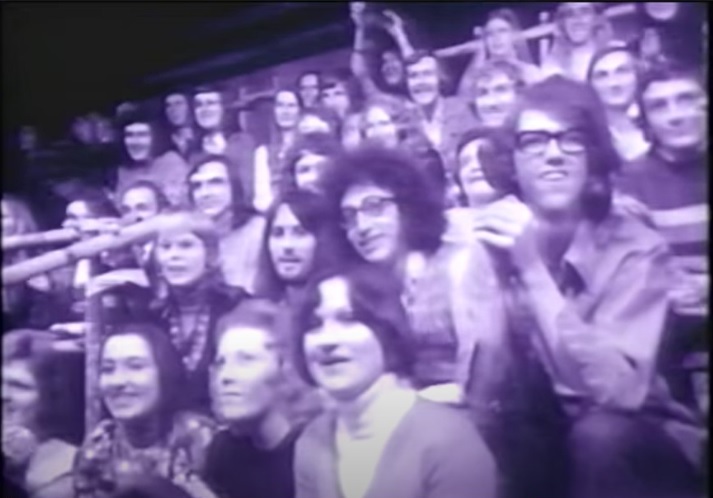
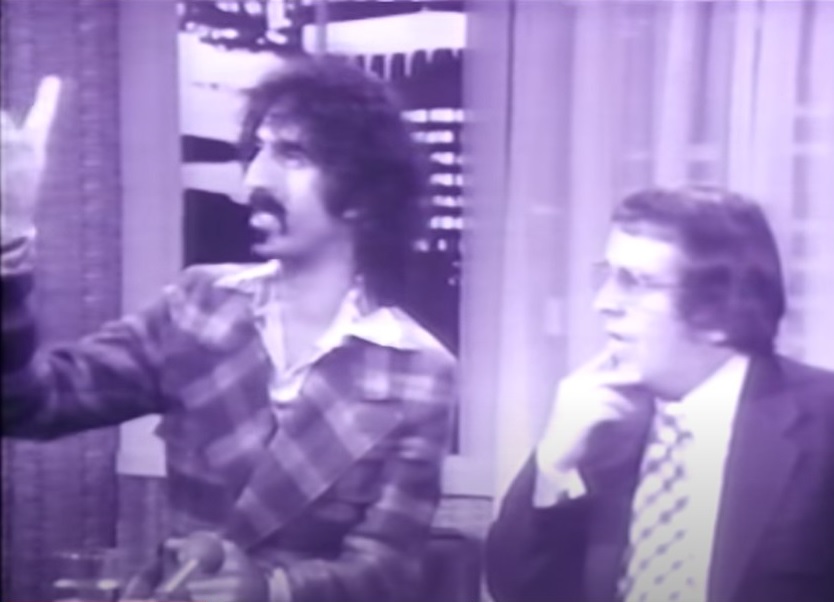
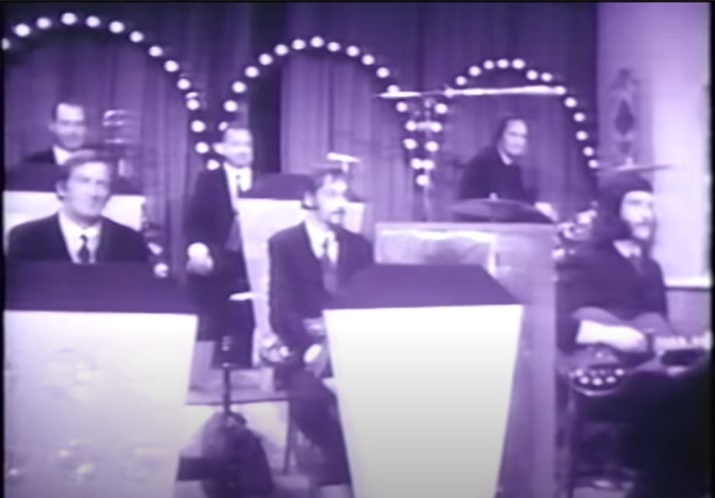
How such indications to the orchestra and audience worked can be seen during an interview in 1973 on an Australian show.
The images above are from a Youtube copy of this interview, also briefly coming by in Zappa's own "Video from hell" video. According to the data available on the Globalia.net site, it's from
a show called "In Adelaide tonight with Ernie Sigley". Here you can actually see and hear Zappa instructing the audience and the studio band how you can build up a little composition
from scratch by giving a number of hand signals. The following is a number of citations of most of what he said regarding these hand signals:
"Sometimes during our shows we'll conduct the audience as a musical instrument. I have hand signals that I use to conduct the band, that give them cues to make
musical sound effects and so forth. Sometimes these cues are extended to the audience, if we have an audience that's in the mood for it. Looks like you guys
might be in the mood for it.
What I'll do is demonstrate first of all what the cues are and then I'll show you how they are to applied to make a piece of music
out of absolutely nothing. Ok, first of all, one finger means get ready to applaud. Ordinarily on TV you have a sign lighting up that says clap your hands. However with this exercise
one finger means get ready to applaud and I'll point to one part of the audience and you start applauding over here and, when my finger goes across, you stop clapping
and the people over here start clapping so you can move the applause around the room like stereo ... It sounds very interesting and you can also get the loudness
and softness of the applause and it'll work pretty nice. [follows a try out].
That's the most simplistic one. Now the next is two fingers. It requires that you make a very low noise, any low noise that you want to make with your mouth on cue
for two fingers like this, now are you ready. And for the band two fingers down like this mean play any low note on your instruments, just sort of bump cut off
like an exclamation point. [follows a try out]. And here is just the opposite of that. The highest possible note on your instrument.
Now we have four possible signals: grunt, peep, clap, put [indicates put symbol to end].
And we're gonna enrich your musical texture now by including a chord, you can choose any not you like. Attack any pitch, increase the volume, and this is bend the pitch down.
This is bend the pitch up."
In the 40th anniversary booklet, Terry Bozzio writes: "I do remember Frank's hand signals and his method of spontaneously composing music by "playing"
the band or orchestra. Certain gestures he used were meant to signal us to play very specific things and great and unexpected events happened when he did this.
Audiences seemed to love it and a lot of humor came out of it for us in the band as well. I'm sure we did some of this with the orchestra."
A bit more in this study about hand signals and audience participation:
- Absolutely free section at "America drinks": Art Tripp showing how Zappa indicated the band to play in 5.
- Weasels ripped my flesh section at "Prelude to the afternoon of a sexually aroused gas mask": other hand signals for the band.
- Tinsel town rebellion section at "Dance contest": audience participation in the shape of a dance contest.
